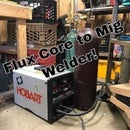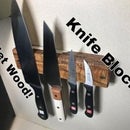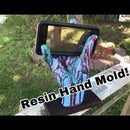Introduction: Making a Edc Fixed Blade Knife
I constantly get asked how I make my knives so I thought I would make a detailed 2 part series of what goes into it. Make sure to check out my youtube video for a more detailed representation. While this is pretty tool intensive you are able to substitute these with basic hand tools.
Heres a list of tools that went into this project,
Belt Sander
Drill Press
Clamps
Vise
Sandpaper
Angle Grinder
Dremel
Supplies
Knife steel
handle material (wood, resin Etc.)
Pin
Glue
Step 1: Shaping the Blade
After drawing out a design I liked on a piece of steel I cut out the shape with an angle grinder. Using a belt sander to grind closer to the desired shape that I want. To get into the tighter curves I use a dremel with a drum sanding attachment.
Step 2: Beveling
This is the part of the process that actually makes the knife sharp. I start by grinding and "sharpening" the knife at a 45-degree angle. I then apply pressure underneath this initial grind slowly moving the grind up the blade creating a more gradual handle. I use a belt sander although you could substitute by using a file.
Step 3: Drilling Holes for Scales and Preparing for Heat Treat
After I beveled the knife I used my drill press to bore holes in desired locations. Using a center punch to prevent the bit from walking. I sent this blade out for heat because I don't have an oven to reach the temperatures that 52100 needs to be hardened. It's important to remember to remove the bulk of material BEFORE heat treat. after heat-treat, files and hand tools won't have an effect on the hardened steel. Powertools and sandpaper are the only ways to finish the blade after heat treat.
Step 4: Final Blade Finishing
After I received the blade back from heat treat I had to remove all the soot and prepare for gluing the handle on. I don't like doing blade finish work after the handle is attached. I take the blade to a 400 grit finish all the way around on the belt sander and with sanding drums. I wanted a bead blast finish so Chris Zep from Make Everything Shop was nice enough to let me use his bead blaster. This step is not necessary but I like the bead blast finish.
Step 5: Handle Prep and Gluing
I chose the handle material I liked, epoxy resin scales. These are resin sales with embedded with aluminum honeycomb. After I taped the scales together I used the blade as a template to locate the holes and drilled through with my drill press. After drilling in finish the fronts if the scales. I do this because it is impossible to sand/ polish this with the blade in the way. I use 2 part epoxy to glue the scales to the tang and use carbon fiber pin through the holes to strengthen the handle. Clamp and wait for the epoxy to set.
Step 6: Handle Shaping and Polish
After the glue has dried I ground the handle material flush to the spine of the knife. I then Bevel the handle material to take off the bulk of the material. Then using the slack of the belt sander I smooth over the angles I just ground into the handle. I finish off the belt sander at 220 grit. Then I move onto hand sanding. starting with 220 grit paper and moving all the way up to 1000-2000 grit. Then using polishing compound buffing the resin out making it shiny.
Step 7: Sharpen Blade and Enjoy!
Lastly I use the flat platten on the belt sander to put a final edge on the knife. And she's done!
I want to thank you all for sticking along and if you have any questions be sure to ask!
Please check out my Youtube and Instagram to see more of what I do!
Instagram @bitterbladeco
Youtube Bitter Blade Co.
https://www.youtube.com/channel/UCMNOOV5ytTH1aCVlvEbVgJw?view_as=subscriber




